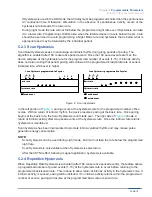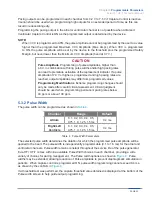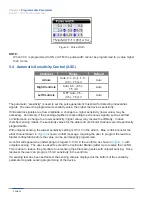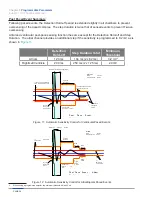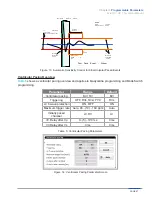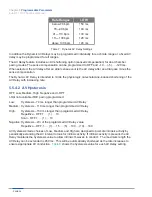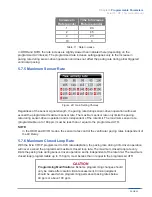
Chapter 5
Programmable Parameters
Evia HF / HF-T Technical Manual
PAGE 32
Rate Ranges
LOW
below 70 bpm
70—90 bpm
91—110 bpm
111—130 bpm
above 130 bpm
150 ms
140 ms
130 ms
120 ms
120 ms
Table 7: Dynamic AV Delay Settings
In addition the Dynamic AV Delays may be programmed individually for each rate range or a fixed AV
delay may be programmed for all ranges.
The AV Delay feature includes an AV shortening option (sensed compensation) for dual chamber
pacing modes. The sense compensation can be programmed to OFF and –10 … (-5) … -120 ms.
When selected, the AV delay after an atrial sense event is the AV delay after an atrial pace minus the
sense compensation.
The Dynamic AV Delay is intended to mimic the physiologic, catecholamine-induced shortening of the
AV Delay with increasing rate.
5.5.4.2 AV Hysteresis
OFF, Low, Medium, High, Negative and I-OPT
I-Opt not available if BiV pacing programmed
Low:
Hysteresis - 70 ms longer than programmed AV Delay
Medium: Hysteresis – 110 ms longer than programmed AV Delay
High:
Hysteresis – 150 ms longer than programmed AV Delay
Repetitive - OFF, 1 … (1) … 10
Scan - OFF, 1 … (1) … 10
Negative: Hysteresis – 2/3 of the programmed AV Delay value
Repetitive – OFF, 1 … (1) … 15 … (5) …100 … (10) …180
AV Hysteresis mode choices of Low, Medium and High are designed to promote intrinsic activity by
periodically extending the AV interval to look for intrinsic activity. If intrinsic activity is present, the AV
Delay maintains the hysteresis value to allow intrinsic R-waves to conduct. The maximum length the
AV Delay can be extended is 450 ms. This will be automatically shortened as the rate increases to
ensure appropriate AV conduction.
Table 8
shows the hysteresis value for each AV Delay setting.
Summary of Contents for Evia HF
Page 1: ...Cardiac Rhythm Management Heart Failure Therapy Evia HF HF T Evia HF HF T Technical Manual...
Page 8: ...Chapter Table of Contents Evia HF HF T Technical Manual PAGE vi...
Page 12: ...Chapter 2 Indications Evia HF HF T Technical Manual PAGE 4...
Page 14: ...Chapter 3 Contraindications Evia HF HF T Technical Manual PAGE 6...
Page 98: ...Chapter 7 Product Storage and Handling Evia HF HF T Technical Manual PAGE 90...
Page 104: ...Chapter 9 Lead Connection Evia HF HF T Technical Manual PAGE 96...
Page 118: ...Chapter 10 Elective Replacement Indication ERI Evia HF HF T Technical Manual PAGE 110...
Page 130: ...Chapter 13 Order Information Evia HF HF T Technical Manual PAGE 122...
Page 132: ...Chapter 14 Order Information Evia HF HF T Technical Manual PAGE 124...
Page 136: ...PAGE 128 Appendix A Evia HF HF T Technical Manual...


